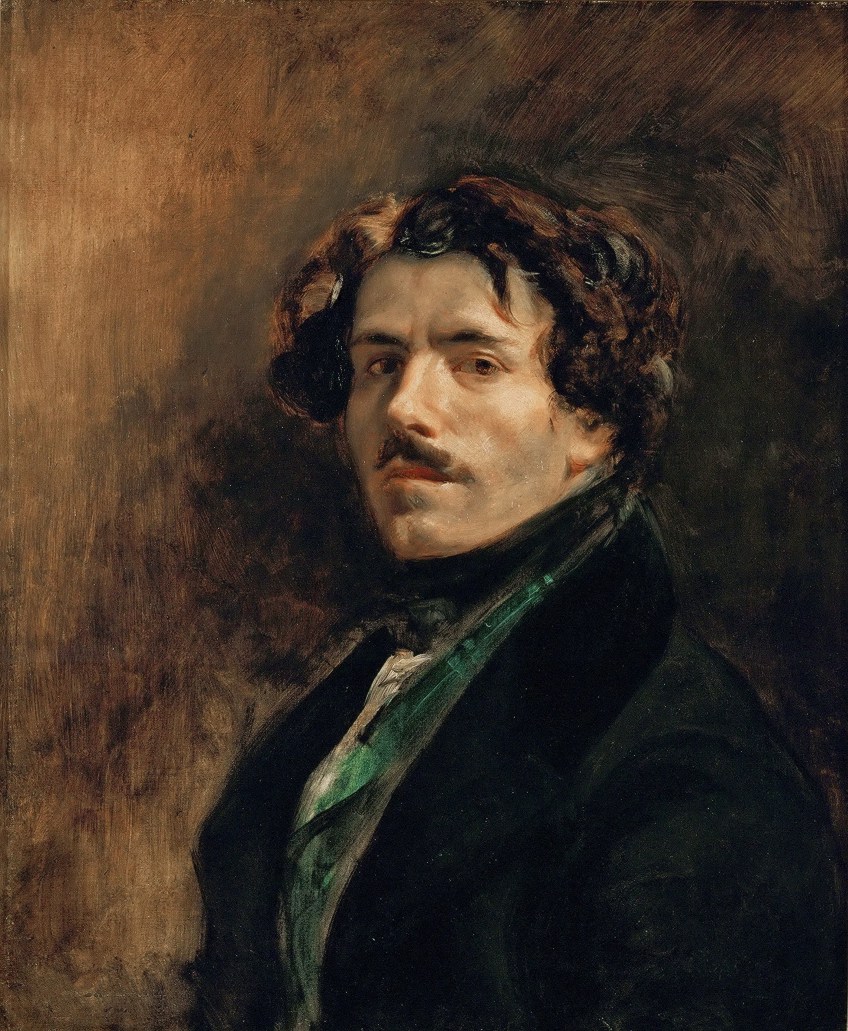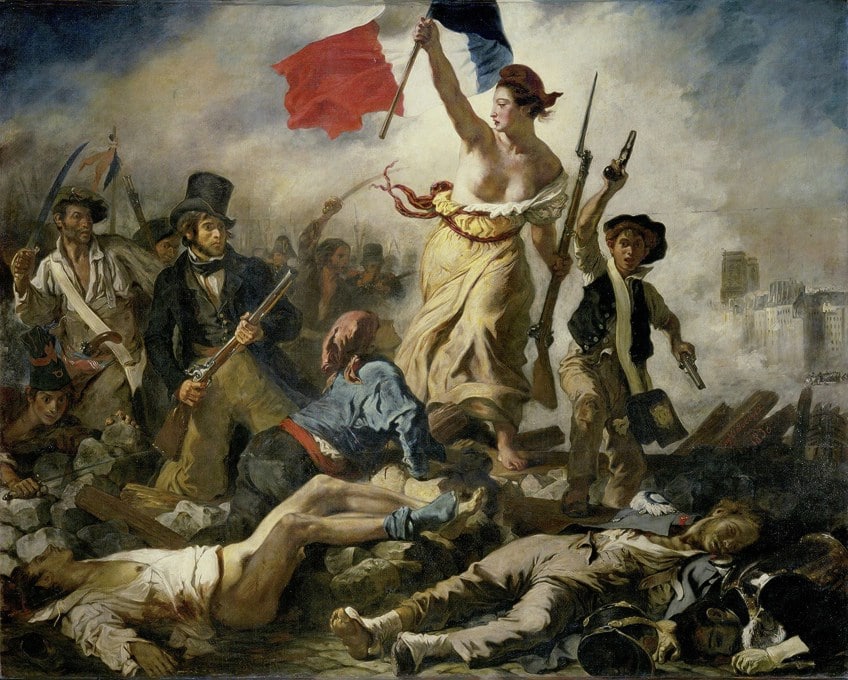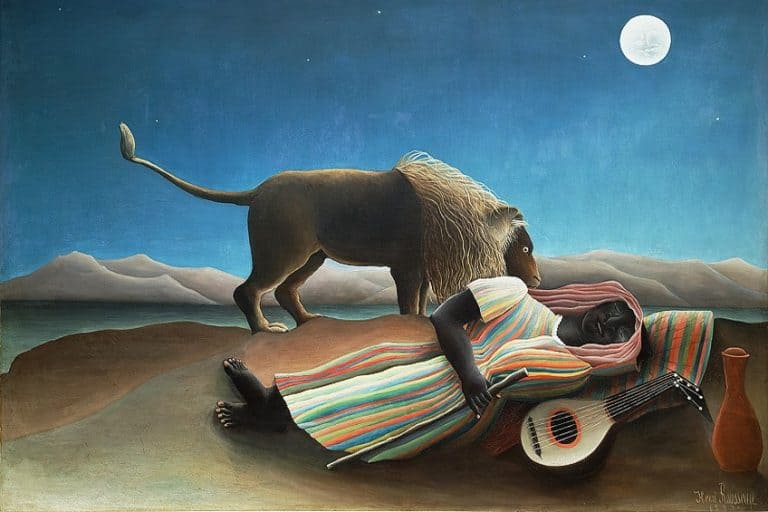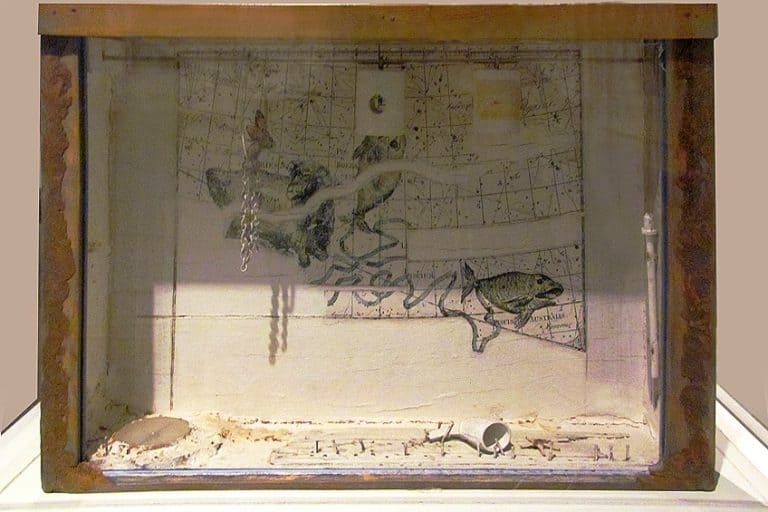Eugène Delacroix – An Overview of French Painter Delacroix
Eugène Delacroix enjoyed a long career and was one of the most influential artists of the 19th century. His bold use of color was as captivating as his thorough and prolific journals. Throughout his career, the legend of French romanticism would find inspiration in historical events, religion, and literature. To further develop his subject matter, he would travel as far as Morocco. A trip that would inspire some of his greatest works. Many well-known artists would subsequently make similar pilgrimages to North Africa.
An Overview of Eugène Delacroix
| Date of Birth | 26 April 1798 |
| Date of Death | 13 August 1863 |
| Country of Birth | Charenton, France |
| Art Movements | Romanticism |
| Genre / Style | Painting, Lithography |
| Mediums Used | Oil paint, watercolor |
| Dominant Themes | Mythical and Religious scenes, Animals, Nature, Colour Symbolism, Orientalism |
French painter Ferdinand Victor Eugène Delacroix is often heralded as the hero of the Romanticism movement. However, his reputation as a pioneer of the Modern Art movement is less well known. Charles Baudelaire, one of the leading critics of the time, wrote: “The majority of the public have long since, indeed from his very first work, dubbed him leader of the modern school.”

Early Years
Eugène Delacroix was born in April 1798, to a fairly well-off family. His mother, Victoire Oeben, was from the Oeben-Riesener family, who were famous artisans and appointed furniture makers for the French king during the 17th and 18th centuries. His father Charles Delacroix was a government official, who had been ambassador to Holland in 1798.
But this picture-perfect upbringing is widely contested.
There are stories that as an infant he was nearly killed in a fire and then through drowning due to negligent caretakers. Charles Delacroix died in 1805, leaving his son relatively penniless. Many claim his real father was Charles-Maurice de Talleyrand-Périgord, a family friend with whom he shares a striking resemblance.

From a young age, Eugène Delacroix’s talents were recognized and he was able to make use of his aristocratic connections. He was acquainted with Antoine-Jean Gros, a well-known historical painter, and even had access to the workspace of the royalist painter Baron François Gérard. In 1815, he began studying under the well-known academic painter Baron Pierre-Narcisse Guérin.
One of the best parts of living in Paris at the time was that it coincided with Napoleon’s rampant looting in Germany, Italy, and other places. Wonderful works of art were taken from private collections belonging to noble families who had been prominent collectors of art.
One of his earlier works was Orphan Girl at the Cemetery (c. 1824), likely influenced by a Goya he had been exposed to around this time. In this work, we begin to see his exploration of his trademark sense of motion and his incredible use of light and color.
In one of his many journal entries, Delacroix wrote: “Splendid day at the Louvre… The Poussins! The Rubens! And above all, Titian’s Francis I! Velazquez! Afterward looked at the Goya’s in my studio with Edouard. Then saw Piron, met Fedel. We all dined together. A good day.”

Neo Classicism vs. Romanticism
Neoclassicists were at the forefront of French art from the 1780s to the 1820s. These artists believed it was their job to represent the good, the pure, and the heroic. Their style was characterized by precise lines, smooth brushstrokes, meticulous lighting, and symmetrical composition. Neoclassicists endorsed logic and Classical training. They believed that the purpose of art was didactic.
In Delacroix’s time, Classicism was being replaced by Romanticism, although they managed to co-exist for quite some time.
With a focus on individuality and self-expression, romanticism’s origins emerged from the notion of the sublime. Its premise and connotations varied in different regions and periods. Romanticism was not confined to painting. Generally, artists rebelled against Classicism because they wanted to make the viewer feel something.

Delacroix’s acquaintance Jean-Louis André Théodore Géricault was a seminal French romantic painter. The Raft of the Medusa (1819) was his most well-known painting. When Géricault died, it made Delacroix the most prominent romanticist painter in France. What personifies Delacroix is the sense of feeling, rather than lines or style.
Delacroix once said: “I do not at all like reasonable painting”. The critic Baudelaire played a huge part in championing Delacroix’s work. Most of what we know as romanticism is based on Baudelaire’s interpretation of Delacroix.
Anglophilia
In 1825, during his first trip to England, Delacroix saw a Shakespeare play. He had wanted to see Joseph Mallord William Turner but Turner was traveling. He was able to visit the studio of Thomas Lawrence, who he greatly admired. After seeing Lawrence’s portraits of elegant English aristocrats, he came back to Paris and painted the Portrait of Baron Schwiter (1826-1830). This painting, even more than Lawrence’s work, became a standard for modern aristocratic representations throughout the century.

Delacroix had a deep love for all things English.
He was fascinated by the way the English dressed and the idea of English elegance, once commenting that everyone dressed “like undertakers”. He admired the painter John Constable, writers like Lord Byron, William Shakespeare, and Sir William Scott. Scott’s work would lead to the creation of Delacroix’s The Murder of the Bishop of Liege (c. 1829). The Death of Sardanapalus (1827) was based on a Lord Byron poem, based on the work of a Byzantine writer, about a Syrian ruler.

If you look closer at the painting, you’ll find even further influences from his admiration for all things English. Compare it to Thomas Lawrence’s Countess of Mexborough with her son, John Charles (1810) and the resemblance in color is striking. The Death of Sardanapalus (1827) was by no means a demonstration of French coloring.
The English palette, which was characterized by a certain vividness of color, was influenced by van Dyke who was painter to Charles the second and Rubens’ chief assistant.
The Death of Sardanapalus
The Death of Sardanapalus (1827) is one of Delacroix’s most controversial paintings. While it was widely criticized, it is one of the most vivid examples of Delacroix’s daring capability with color, form, and composition. Because of the criticism, Delacroix found it hard to sell the painting, only selling it in 1844 to an Englishman named Wilson.
Sensing that he would lose a piece of himself at his most controversial, he made various versions, accentuating aspects of the painting that had been criticized.

According to the story, Sardanapalus was a Syrian emperor whose city was under attack, in flames. You see a glimpse of it on the upper right-hand side of the painting. To keep them from his enemies, he instructs his guards to destroy all his treasures, including his harem, his slaves, and his jewels. The angle at which we are looking at Sardanapalus’ bed has an element of danger. The composition is precarious. The chaotic, violent subject matter is amplified by how it is painted.
The main figure, Sardanapalus, is pushed far off-center and the middle is quite sparse. This is in stark contrast to the neo-Classicist tradition of the time, which was based on distinct lines, a central subject, and symmetry. Instead, Delacroix lets us savor the incredible richness of color.
Different versions of this painting have different effects, with one more controlled and the other looser, allowing the brush strokes to emphasize the color.

While there is a lot of killing going on, most notably, the woman on the bottom left part of the painting, we see no blood at all. The symbolism of blood is in strong contrasts of color across the painting. The blood-red bedsheets, the cushions, ropes, and other embellishments stand in the place of blood. It is a psychological trick – a play on the viewer’s emotions.
Morocco
After the French had conquered Morocco, Delacroix used his contacts to secure a visit to Morocco with French diplomats for the king in 1832. Even though he’s not particularly interested in diplomacy, he welcomes the opportunity to find new material. Based on his observations of the lives of North African people, he produced over a hundred sketches. He would use these sketches to make paintings back in Paris, even many years after.
He continued to return to the themes he had seen in North Africa throughout the rest of his life.
One of the paintings that resulted from this trip was his Women of Algiers in their Apartment (1847-1849). He almost certainly wouldn’t have had access to a scene like this, given that harems would have been very private and closed off to him. Nonetheless in 1847, 15 years after he’d been to Morocco, he conjured this image which would become one of the most influential in his oeuvre.

Another of these intriguing paintings is The Convulsionaries of Tangiers (1837-1838) made five years after he was in North Africa. It depicts a Sufi religious festival in which Sufi men pour onto the city streets in great states of passion. Again Delacroix would only have had a glimpse of this scene, perhaps through windows or rooftops.
The fact that he remembered it so vividly five years later, editing and adding those intense contrasts of color, is quite remarkable.

When he went to Morocco he didn’t want to paint just men. However, the only women he had access to were Jewish women because of the strict rules surrounding Arab women. In his painting Jewish Wedding in Morocco (1839) you can see his departure from the classical painting that was popular in Paris at the time. This kind of scene would have been exotic and strange to French audiences.
He continued to innovate with his transitions of light and use of reds and blues, which created depth through intensity and contrast.

Early Salon Works
By the 1820s, the Salon had become the main exhibition in Paris and the international contest of choice. But it was still intended mainly for the French, as opposed to the 1870s where with a population in Paris of about 200 000, there were about 5 million visitors a year coming to the Paris Salon.
The works submitted were guided by the demands of the small judging panel of the Salon. Despite this, Delacroix never made the most popular decisions.
His very first submission to the Salon was Dante and Virgil in Hell or The Barque of Dante (1822, Musee du Louvre, Paris). In it, Dante and Virgil are on a boat together, crossing a river that carries you either to paradise or hell after you die. In the water around them are the bodies of the lost souls who are neither in heaven nor in hell. It’s a large work, measuring 74 by 95 inches. By his own account, he was influenced by Theodore Géricault’s The Raft of the Medusa (1819).

Both paintings have the same sense of lighting, dramatic gestures, and twisted bodies. A sense of precarious drama, terror, and awful tragedy, fitting the romantic genre. The paintings even share a sense of compositional direction.
One of the criticisms of Géricault’s painting by the panel of judges at the Salon academy was that it was “just a pile of dead bodies”. The same could be said about the Delacroix.
The Massacre at Chios (1824) which is derived from Lord Byron, depicts the Greek invasion by the Ottoman Turks. Delacroix takes up the narrative of the refugees in the battle who await their fate. His preparatory watercolors on paper Study of the Massacre at Chios (c. 1820) demonstrate his focus on color. The intensely dark middle ground and a more atmospheric background are tantalizing signs of future mastery.

Mature Work
While the criticism continued, so did Delacroix. He wrote: “Criticism, like so many other things, keeps to what has been said before and does not get out of the rut. The business of the ‘Beautiful’: some see it in curved lines, some in straight lines, but all persist in seeing it as a matter of line. I am now looking out of my window and I can see the most lovely countryside. Lines just do not come into my head. The lark is singing, the river sparkles with a thousand diamonds, the leaves are whispering.”
He continued, “Where I should like to know, are the lines that produce delicious impressions like these? They refuse to see proportion or harmony except between two lines. All these they regard as chaos, and the dividers alone are the judge.”
Shortly afterward, he produced The Sea from the Heights of Dieppe (1852), which is even less like the French classicists. Visible in this work is some influence from Turner and Monet. The young impressionists are particularly taken by his interpretation. His flexibility and free-thinking were distinct. While he was criticized by the academy for being ruled by passion and not logic, he seemed engaged in both the past and the future of art.

His influences ranged from Rubens to Da Vinci, denoting an aspiration that was rarely matched. His painting The Lion Hunt (1855), including its preparatory sketch of 1854, when compared to Peter Paul Rubens’ The Tiger Hunt (1617-1628), shows the undeniable influence.
Through a study of Rubens, he seemed to be articulating how tone and color can be just as complex as line.
Delacroix once said: “How strange that I never noticed until now the extent to which Rubens proceeds by means of halftone, especially in his finest works! His sketches ought to have put me on the track. In contrast to what they say about Titian, he first lays in the tone of his figures which appear dark against the light tone”.

Religious Paintings
In the 1850s, Delacroix was commissioned to do murals for Saint-Sulpice, a church in Paris. Heliodoros Driven from the Temple (1854-1861) is based on a story in the book of Maccabees, of a Syrian who tries to steal riches from the temple. As he’s about to ascend the steps, an angel appears and drives him out of the temple. Delacroix is looking to Raphael, borrowing from the School of Athens. He’s also looking at Tinteretto’s The Miracle of St. Mark Freeing the Slave (1548).

The most famous Saint-Sulpice mural was Jacob Wrestling with the Angel (c. 1854-c. 1860). Around this time he was being commissioned for several other murals including but not limited to the ceiling of the Galerie d’Apollon at the Louvre in 1850. These would be among the last in the tradition of Baroque ceiling painting.
By this time, Delacroix had been accepted into the academy and was even praised for the Michelangelo touch in this painting.

His other religious paintings of this time include Crucifixion (1845), praised for the looseness of form. Christ on the Sea of Galilee (c. 1854) depicts a boat being tossed on the stormy waters. The disciples are panicked and terrified while Christ remains placid, seeming close to a slumber, unperturbed by the storm raging around him. The preparatory studies for this work are also perplexingly beautiful, highlighting Delacroix’s fixation on motion and color.

Revolution
In the 1830s, France found itself in a state of revolution, which crowned Louis-Philippe as the new French monarch. Moved by the political spirit of the time, Delacroix painted Liberty Leading the People (1830), which is probably his most famous work to date. The success of the painting solidified his reputation as a French painting heavyweight.
It caused such a stir that the state bought the work, put it in the Luxembourg Museum for a few months, and then took it down and quietly gave it back to Delacroix.
In the painting, we are presented with an idealized figure of lady liberty. Delacroix didn’t invent this figure. It was an old archetype, extending back to ancient Greece. The allegorical figures of love and liberty were often idealized female figures. Delacroix himself said that “Liberty” wasn’t a real woman. Those weren’t real breasts, even the light that falls on her is unearthly compared to the figures around her.

The scene around her appears all too real in contrast. The dead bodies, particularly the half-naked figure at the bottom of the painting represent the stark reality of the time. These were all middle-class people, fighting for their right to be recognized by the state. Almost all of those who died were young men.
Even though feminists would co-opt this image, because of the centrality of Lady Liberty, this was not Delacroix’s intention. Women in France didn’t get the vote until 1946.
Delacroix was conservative. He was from a Bonapartist family which meant he didn’t trust the idea of mob rule. During the years following the Revolution, he would resist making paintings that depicted Mary Antoinette’s execution, for example, like other artists. In 1848, he simply left Paris and went to his summer home in Champrosay. There he began to paint large pictures of fruits and flowers. While such paintings are usually associated with daintiness and politeness, he seemed to be revolutionizing the genre.
The Influence of Eugène Delacroix
When we look at how many well-known artists were influenced by Eugène Delacroix, it’s not difficult to surmise that he was one of the most influential artists of his time. Young artists looked up to him because unlike many of his peers, Delacroix did not want to waste time on drawing. He was interested only in paint and color. He wanted to allow the picture to evoke the subject rather than illustrate it.
Delacroix showed the next generation how to do audacious things. This is how his legacy was carried on.
In 1859, Edgar Degas sketched a detailed copy in pen and ink of Delacroix’s painting, called Ovid among the Scythians (1859). A few pages later, he sketched the painting The Spartan Youths (1859). Degas was an avid art collector, but he had more works by Delacroix than by any other artist. This shows us that he must have been thinking of Delacroix when making his own work.
Paul Cézanne famously said: “You can find all of us in Delacroix”. French scholar of Cézanne, François Kashan, made the observation in the mid-1990s that Cézanne had indeed transposed The Death of Sardanapalus. The Eternal Feminine (c. 1877) has the same composition as Sardanapalus. The frenzy around him is replicated by the frenzy around her. In his desire to do something big and dramatic, Cézanne goes back to the model of Delacroix. He even seems to have represented Delacroix himself within the painting as the artist capturing the scene.

There is an old photograph of Cezanne’s River Landscape (1881) with an annotation by Cezanne’s son which says “copy de Delacroix”. it’s not certain if it is indeed a copy of a Delacroix, but it certainly offers insight into Cezanne’s process. Cezanne’s The Apotheosis of Delacroix (c. 1890-c. 1894) in pencil and watercolor shows a naked Delacroix being assumed into heaven.
While on the ground, he seems to be exalted by great landscape painters (left to right: Chocques, Renoir, Cezanne, Monet, and Azaro). It seems they’re adoring Delacroix the landscape painter as the scene is depicted in the open air.

In 1888 good friends Paul Gaugin and Vincent van Gogh got on a train to Montpellier to see the Women of Algiers in their Apartment (1847-9). In a letter van Gogh wrote, “my discussions about Delacroix with Gaugin were electric”. Both artists were particularly fascinated by his images of North Africa. Many of van Gogh’s early paintings had a certain brownness to them, but after his interest in Delacroix, his images became explosive with color.
Delacroix’s Pietà (1850) was made famous when Vincent van Gogh made a copy of it. When observing the two side by side, you notice that van Gogh’s copy is backward. This is because van Gogh traced a lithograph of Delacroix’s sketch. Van Gogh’s Pietà (1889) is in the Vatican Museum. He also copied Delacroix’s The Good Samaritan (1848) with the same reversal due to being traced from a lithograph.

Gaugin saw himself channeling Delacroix; he was even known to remark that he thought they looked alike. He often traveled with images of works by Delacroix and when he was in Martinique in 1887, he painted Still Life with Fruits and a Sketch after Delacroix (1887). In the top part of the painting, you see what looks like a photograph of Delacroix’s oil sketch, The Expulsion of Adam and Eve from Paradise (1844).
Gaugin was also intrigued by Delacroix’s use of color for expressive purposes and for intensifying emotion.
You can see this influence when you compare Delacroix’s Jacob Wrestling with the Angel (1855-1861) and Gauguin’s famous painting The Vision After the Sermon (1888). Both paintings share the theme of Jacob wrestling the angel and the dream-like division between the vision of the wrestling and the people passing by or spectating. This painting is a direct quotation and Gauguin would continue drawing from Delacroix in Tahiti where his use of color begins to subsume the meaning of his paintings.

Pierre-August Renoir was one of the artists who was most influenced by Delacroix and his use of color. Renoir’s painting Odalisque: Woman of Algiers (1870) was painted long before Renoir had himself been to North Africa. It was painted in the Delacroix style. Renoir seems to be demonstrating that he can do a Delacroix. In 1875, he made Portrait of Victor Chocquet, a man who was a collector of Delacroix’s work. In the portrait, Chocquet is painted standing in front of a Delacroix painting which appears as a kind of halo around his head.
That same year, Renoir was commissioned to paint “Jewish Wedding in Morocco” after Delacroix. He made a faithful copy of the same size. While it was a worthy homage, you can tell who was the master and who was the student.
Finally in 1881, having imagined North Africa through Delacroix’s eyes, Renoir went to Algeria and painted some of his most audacious pictures. Renoir’s The Mosque (1881) has similar energy to Delacroix’s The Convulsionaries of Tangiers (1837-1838) which had been made 40 years earlier.

Henri Matisse read Paul Signac’s book in which he championed what he saw as Delacroix‘s ‘scientific’ use of color. Signac claimed that Delacroix had led the way to modern painting which in turn led to the post-impressionist pointillist style that Signac was invested in. As he had been trying to master color, Matisse took up pointillist painting but eventually realized he wanted to use color more boldly. He went to Morocco in search of the big bold vision of what Delacroix had done 80 years prior. This period became his great breakthrough.
Around the same time, Wassily Kandinsky, the Russian artist, was writing Concerning the Spiritual in Art, asserting that modern art would be abstract and based on bold color. That it was Delacroix who led the way, allowing art to break free from mere representation through his bold use of color. Pablo Picasso is also known to have been influenced by Delacroix. One of Picasso’s most celebrated series Women of Algiers (1954–1955 ) is a monumental symbol of this influence.
In the days following Delacroix’s funeral, some people including Edward Manet, James McNeal, and Charles Baudelaire, decided that they would do something to honor the great painter at the Paris Salon.
A portrait of Delacroix by Henri Fantin-Latour, Homage à Delacroix (1864), was shown at the Paris Salon of 1864. Many of these young artists, who themselves weren’t yet as famous as Delacroix had been, would become recognized as the next generation by gathering in honor of Delacroix. Henri Fantin-Latour would also later go on to make Immortality (sprinkling Roses on the Tomb of Delacroix) (1889).

The Beginning of the End
Ovid Among the Scythians (1859) was the last painting Delacroix ever submitted to the Paris Salon. It was met with some hostility, although it must be said 1859 wasn’t a good year for the salon overall. Audiences were beginning to realize that French art was stagnant and that painting wasn’t going anywhere. They needed a revolution.
While Baudelaire declared the painting as a great renewal of the genius of Delacroix, many others were perturbed by its confusing logic of scale.
Ovid on the left-hand side of the painting appears tiny in comparison to the huge mare he’s being fed milk from. It appears about three times larger than any horse could be and this was seen as a lack of control. The composition of the rest of the painting was also under question.

There seemed to be no discernible method in the way the figures were plotted around the landscape which made the painting appear quite arbitrary to many critics. One critic, in contrast to Baudelaire, declared that it was over for Delacroix.
He had a long illness and died in Paris in August 1863. He was 65 years old. He decreed that the contents of his studio be sold, to pay off his debts, give money to his favorite servants, family, friends, and so on. The sale took place in 1864 where thousands of his works were made available at affordable prices. The sale revealed that Delacroix was an avid painter of landscapes though he rarely showed them. Their discovery influenced young impressionists who were obsessed with the theme of landscapes.
It would be hard to trace exactly how influential Delacroix has been. Many contemporary techniques and methodologies were pioneered by him because so many great artists drew from his work. His ample and philosophical journal entries give us an insight into the artist’s mind. He was an innovator who was not afraid to go against the grain, while he still respected and attempted to emulate old masters. His long career had its ups and downs, but in the end, his undeniable oeuvre remains as evidence of the epic feats a great artistic mind can achieve.
Take a look at our Delacroix paintings webstory here!
Frequently Asked Questions
Was Delacroix an Orientalist?
Delacroix was at the forefront of what many might call Orientalism. He’s one of the first French artists to travel to North Africa, starting a long trend of artists who did so for the benefit of their work.
How Influential Was Liberty Leading the People?
French sculptor Frederic Auguste Bartholdi made the model for the Statue of Liberty (1870-1886), based on Delacroix’s Liberty Leading the People. Victor Hugo’s Les Misérables was also influenced by this painting.
How Did Delacroix Make His Name?
Though he was heavily criticized for his alternative style of art, Eugène Delacroix would consistently receive patronage from the French government. Many attribute this partly to his connections, coming from a respected family and particularly the unwavering support of his distinguished supposed father Charles-Maurice de Talleyrand-Périgord.
Heidi Sincuba was the Head of Painting at Rhodes University from 2017 to 2020 and part of the first Artist Run Practice and Theory course at Konstfack in Stockholm, 2021. They completed their BFA at Artez Arnhem in the Netherlands, MFA at Goldsmiths University of London, and are currently a Ph.D. candidate at the University of Cape Town.
Heidi Sincuba’s own practice explores fugitivity through painting, drawing, text, textiles, performance, and installation. This praxis is founded on a conceptual intersection of biomythographic experimentation, existential automatism, and African ancestral knowledge systems. These methodologies of multiplicity result in a fluid and speculative aesthetic, continually manifesting and metamorphosing its material conditions.
Learn more about the Art in Context Team.
Cite this Article
Thembeka Heidi, Sincuba, “Eugène Delacroix – An Overview of French Painter Delacroix.” Art in Context. March 1, 2022. URL: https://artincontext.org/eugene-delacroix/
Sincuba, T. (2022, 1 March). Eugène Delacroix – An Overview of French Painter Delacroix. Art in Context. https://artincontext.org/eugene-delacroix/
Sincuba, Thembeka Heidi. “Eugène Delacroix – An Overview of French Painter Delacroix.” Art in Context, March 1, 2022. https://artincontext.org/eugene-delacroix/.











